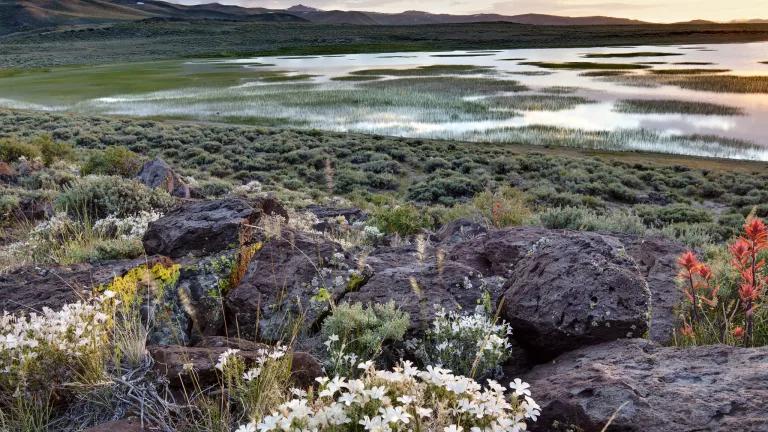
Thousands of people in Chile and around the world celebrated when Chile’s government overturned HidroAysén’s environmental permits on June 10, 2014, assuming it was an indication that the country’s rugged, remote Patagonian region would remain safe from large dams. The seven-year campaign to stop HidroAysén—a 2,750 MW hydroelectric complex proposed on Patagonia’s Baker and Pascua Rivers—known broadly as “Patagonia Sin Represas” (“Patagonia without Dams”), was the largest environmental movement in Chile’s history. It proved that local communities working in partnership with national and international actors and organizations, could defeat a poorly planned project backed by powerful national and multi-national companies. (Full disclosure: NRDC is a member of the coalition that worked to stop HidroAysén, called the Patagonia Defense Council.)
Since then, a lot of people have said to me, “HidroAysén is dead! Patagonia is safe, there’s nothing else to do, right?”
Unfortunately, no.
The rivers of Chile’s Patagonia remain at risk of industrial-scale hydroelectric development as other big projects advance and the government envisions large hydroelectric power as a cornerstone of the country’s energy future. Here is a brief summary of two of the most controversial large hydro projects that continue to threaten the country’s free-flowing rivers.
The largest and most well-known hydroelectric proposal moving forward at the moment is the Rio Cuervo project, planned for the Patagonia region of Aysén, like HidroAysén was. The Rio Cuervo dam is owned by Energía Austral, a joint venture of the Swiss mining company Glencore (66 percent owner) and the Australian energy company Origin Energy (34 percent owner). However, recent reports signal that Glencore is looking to sell some or all of its shares in the project. The 640 MW proposal is the first of a three-dam complex, to be followed by the 375 MW Blanco and 50 MW Condor hydro plants nearby.
The Rio Cuervo project is also, according to local experts, extremely poorly planned, for a variety of reasons. To summarize a few of the main concerns:
- The dam would be built in the active Liquiñe-Ofqui fault zone, and any failures of the dam could dramatically impact the community of Puerto Aysén, located just 46 kilometers (about 28.6 miles) downstream.
- The reservoir would flood almost 6,000 hectares (about 15,700 acres) of untouched wilderness, adjoining the pristine Lakes Yulton and Meullín.
- The company failed to meet the International Labor Organization’s standards for indigenous consultation, known as ILO Convention 169, while planning the dam.
- The project’s full impacts cannot be known or assessed at this time because the company has yet to present its plan for the transmission line, needed to carry the electricity to the main grid hundreds of kilometers away, and the plans for the Blanco and Condor dams.
The Rio Cuervo project received its environmental permits in 2013, and withstood appeals to the Committee of Ministers, which backed the approval in January this year. In April, local organizations and citizens filed a new appeal to the dam, which highlights that the members of the Committee of Ministers met with the Rio Cuervo project’s proponents, but not with the local communities while evaluating the case. If the authorities side with the locals against the dam, the permits would have to be re-evaluated.
The second project that has caused national controversy lately in Chile is the Mediterráneo project, which is also referred to by the name of the rivers it would be located on: the Rio Puelo or Rio Manso. The $400 million, 210-MW project is unlike most other large hydro proposals in Chile now, because it would be a run-of-the-river plant, and is owned by local Chilean investors. It would be built at the confluence of the Torrentoso and Manso Rivers, both tributaries of the Puelo River, whose entire basin begins at the Puelo Lake in Argentina and flows west into Chile and down the Andes to the Pacific Ocean. I was lucky enough to visit the area in 2015, and I can say—even on a cloudy, dreary day—it is a truly gorgeous part of the planet.

Even though the project received its environmental permits in 2013, and those permits were upheld by the Committee of Ministers in November 2015, many in the local community are still opposed to the project. Among their chief concerns are:
- The 63 kilometer-long (about 39 miles) transmission line needed to connect the plant to the main grid would run along the most scenic and visible parts of the area, impacting the local tourism industry.
- The project’s proponents failed to comply with the ILO’s Convention 169 by not consulting with the indigenous Mapuche community of Santo Domingo Cayun Panicheo before the project’s approval.
- A number of legal irregularities have arisen throughout the project’s evaluation process.
- The environmental impact assessment was poorly done.
Most recently, Chile’s Environmental Superintendent halted work on the project after the company began constructing a road it was not permitted to build. At the same time, members of Chile’s lower house of Congress have shown their support for the local community opposed to the project.
Finally, it is worth noting that HidroAysén simply refuses to die. The company has recently filed new appeals against the General Water Directorate’s denial of the water rights it applied for in order to build their dams, and that case is pending.
The backdrop to all of this is the fact that the government’s long-term National Energy Policy sets the new target of generating at least 70 percent of Chile’s energy with renewables by 2050, including large hydropower. (Disclaimer #2: On behalf of NRDC, I participated in the Advisory Committee that helped draft recommendations for the policy.) While the policy is, overall, a very encouraging and positive document, and the Ministry of Energy deserves congratulations for the difficult task of creating it, that goal is one that we believe can be met without large hydro—that is, with non-conventional renewable energy and energy efficiency.
Next week, I’ll post a new blog on the latest developments in Chile’s sustainable energy sector, and underscore why large hydropower does not belong in that category. In the meantime, Chileans fighting to protect their country’s rivers are all over social media, and I encourage you to read more about their work—here are a few Twitter links to get you started: #PatagoniaSinRepresas, #LaBatalladePuelo, #Futaleufu.




